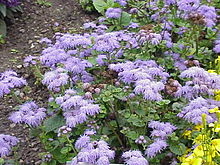
Back يوباتورى ARZ Eupatorieae Azerbaijani Eupatorieae Catalan Eupatorieae German Eupatorieae Spanish Eupatorieae Croatian Eupatorieae Italian 등골나물족 Korean Посконниковые Russian Eupatorieae Turkish
| Eupatorieae | |
|---|---|

| |
| Ageratum houstonianum | |
| Scientific classification | |
| Kingdom: | Plantae |
| Clade: | Tracheophytes |
| Clade: | Angiosperms |
| Clade: | Eudicots |
| Clade: | Asterids |
| Order: | Asterales |
| Family: | Asteraceae |
| Subfamily: | Asteroideae |
| Tribe: | Eupatorieae Cass. 1819 |
| Subtribes[1] | |
Eupatorieae is a tribe of over 2000[2][3] species of plants in the family Asteraceae. Most of the species are native to tropical, subtropical, and warm temperate areas of the Americas, but some are found elsewhere.[4][5] Well-known members are Stevia rebaudiana (used as a sugar substitute), a number of medicinal plants (Eupatorium), and a variety of late summer to autumn blooming garden flowers, including Ageratum (flossflower), Conoclinium (mistflower), and Liatris (blazing star or gayfeather).
Plants in this tribe have only disc florets (no ray florets) and their petals are white, slightly yellowish off-white, pink, or purple (never a full yellow).[4][6]
Within the aster family, the Eupatorieae are in the subfamily Asteroideae.[7] Within Asteroideae, they are in the supertribe Helianthodae.[8] Within Helianthodae, they belong to an informal group without taxonomic rank called the phytomelanin cypsela clade, which contains 11 tribes.
The sister tribe of Eupatorieae is probably Perityleae. This result received moderate statistical support (68% bootstrap percentage) in a study published in 2002.[9]
- ^ Susanna, Alfonso; Baldwin, Bruce G.; Bayer, Randall J.; Bonifacino, José Mauricio; Garcia‐Jacas, Núria; Keeley, Sterling C.; Mandel, Jennifer R.; Ortiz, Santiago; Robinson, Harold; Stuessy, Tod F. (2020). "The classification of the Compositae: A tribute to Vicki Ann Funk (1947–2019)". Taxon. 69 (4): 807–814. doi:10.1002/tax.12235. S2CID 225592435.
- ^ H. Robinson; R. M. King (February 1985). "Comments on the Generic Concepts in the Eupatorieae". Taxon. 34 (1): 11–16. doi:10.2307/1221557. JSTOR 1221557.
- ^ D.J.N.Hind & H.E.Robinson. 2007. Tribe Eupatorieae In: The Families and Genera of Vascular Plants vol.VIII. (Joachim W.Kadereit & Charles Jeffrey, volume editors. Klaus Kubitzky, general editor). Springer-Verlag. Berlin, Heidelberg.
- ^ a b "187n. Asteraceae tribe Eupatorieae". Flora of North America (Vol. 21 Page 456, 459). Retrieved 2007-10-06.
- ^ Turner,B.L.(1997). Eupatorieae. In: Turner,Billie Lee (editor) The Compositae of Mexico. A systematic account of the family Asteraceae, vol.1. Phytologia Memoirs 11:i-iv,1-272.
- ^ "Asteraceae Tribe EUPATORIEAE (draft)". Archived from the original on October 10, 2008. Retrieved 2007-10-06.
- ^ Panero,J.L. & Funk,V.A. (2008). "The value of sampling anomalous taxa in phylogenetic studies: Major clades of the Asteraceae revealed". Molecular Phylogenetics and Evolution. 47 (2): 757–782. doi:10.1016/j.ympev.2008.02.011. PMID 18375151.
- ^ Robinson,H.E. 2002. "New supertribes, Helianthodae and Senecionodae, for the subfamily Asteroideae (Asteraceae)". Phytologia 86(3):116-120
- ^ Panero,J.L., & Funk,V.A.. 2002. "Toward a phylogenetic subfamilial classification for the Compositae (Asteraceae)". Proceedings of the Biological Society of Washington 115(4):909-922
© MMXXIII Rich X Search. We shall prevail. All rights reserved. Rich X Search